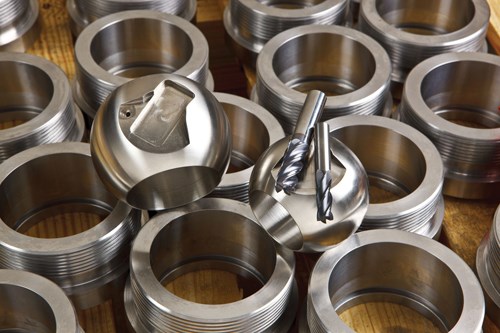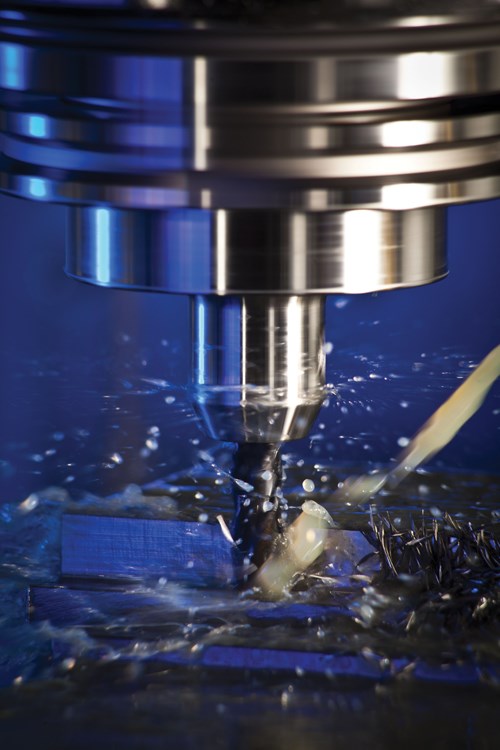Even with CAM software strategies that dramatically improve machining efficiency, success can still hinge on the tool. That lesson was recently driven home for Kline Oilfield Equipment when the Tulsa, Oklahoma-based oilfield industry manufacturer encountered tool life difficulties during a tough Inconel job. Achieving the gains the company had come to expect from its new CAM software required a counterintuitive swap: replacing an end mill designed specifically for hardened materials such as Inconel with a general-purpose model from Imco Carbide Tool (Perrysburg, Ohio). The result was a 500 percent increase in tool life and an 86 percent reduction in cycle time.
These improvements were similar to what the company had seen on other applications since implementing iMachining, a CAM module from software developer SolidCAM (Washington Crossing, Pennsylvania). In essence, the software’s algorithms adjust feed rates and stepovers throughout the tool path in order to keep the mechanical and thermal load on the cutter constant. According to the developer, this enables deeper, faster and more efficient cutting with less wear and tear on tools and machines.
Much of the responsibility for implementing iMachining at Kline Oilfield Equipment fell to Jake Aasness, who handles programming and technical applications. He had been testing the software with various tools and materials when the company received an order for ball valves in 718 Inconel, a job that recurs once or twice a year. “It’s an absolute nightmare every time,” he says. “It would usually take two tools to get through one part. Cycle time was two hours.”
However, Mr. Aasness says he expected this time to be different. After all, this particular job seemed an ideal fit for the company’s new CAM software. The ball valves were machined on a VMC with a fourth-axis rotary table, and milling in the rotary fourth-axis can leave much to be desired in terms of rigidity, he says. That alone can wreak havoc on cutting tools. Moreover, traditional machining methods—entering the workpiece head-on and taking deep radial cuts with frequent tool re-entry—can increase tool wear exponentially. By keeping the tool engaged in the work and the cutting forces uniform, iMachining would eliminate much of the stress on the end mill and enable higher metal-removal rates, even with a less-rigid setup. The company had also chosen a tool that seemed well-suited for the task. Featuring a custom variable flute and index design to reduce chatter and vibration, the AlTiN-coated end mill was recommended for aggressive applications in hardened materials like Inconel.
Nonetheless, the cutter failed before finishing the second part. The machinists at Kline were stunned, Mr. Aasness recalls. Something about the combination of the tool, the tool path, and the setup just wasn’t working. Suspecting the software was not the problem, he decided to swap tools.
He might normally have reached for another high-performance end mill from a different manufacturer, such as the Pow-R-Feed or enDuro end mills from Imco. Both of these tools are typically kept in stock at Kline Oilfield Equipment, but none were available that day. So he opted instead for Imco’s general-purpose end mill: the four-flute Everyday Advantage with Spector (AlTiN) coating. Mr. Aasness had been using this tool for years, but never to cut Inconel, in large part because that material isn’t listed on the application chart. He forged ahead anyway and set up the tool to run wet at 4,074 rpm and 50-60 ipm.
Mr. Aasness soon found himself watching the tool carve a 0.486-inch-deep, 2 1/2-inch-diameter pocket in a single pass. After finishing two complete ball valves with no problems, he used the same tool to run 12 additional parts in 4140 heat-treated stainless steel. “It probably could’ve run 10 more,” he says. Since then, he has pushed speeds and feeds to 6,000 rpm and 100 ipm, respectively. The shop now produces five parts per tool compared to two or less before, and cycle time per part has been reduced from two hours to 16 minutes.
Chris Cooper, who has been Kline’s Imco representative for more than eight years, says he’s not exactly sure why the first, high-performance cutter didn’t work. “We’re still scratching our heads,” he says. However, he suspects that the performance of the Everyday Advantage results from a combination of edge preparation, substrate and coating.
Tim Elfreich, sales manager for Imco, agrees. Although high-performance tools might vary widely from manufacturer to manufacturer, general-purpose tools all tend to have similar geometry—helix angles, rake angles and so forth vary only slightly from one product to another, he explains. Considering this basic geometry is generally not recommended for a material like Inconel, the best explanation for the tool’s performance lies in how it is applied and the three areas where the manufacturer can exert the most control. “We take great pains to make sure that the grinds are consistent and repeatable, and we don’t cut corners on the substrate or the coating,” Mr. Elfreich says. “When you combine that with advanced tool paths and techniques like those provided by iMachining, even a basic product can provide outstanding results.”

















.jpg;maxWidth=300;quality=90)








